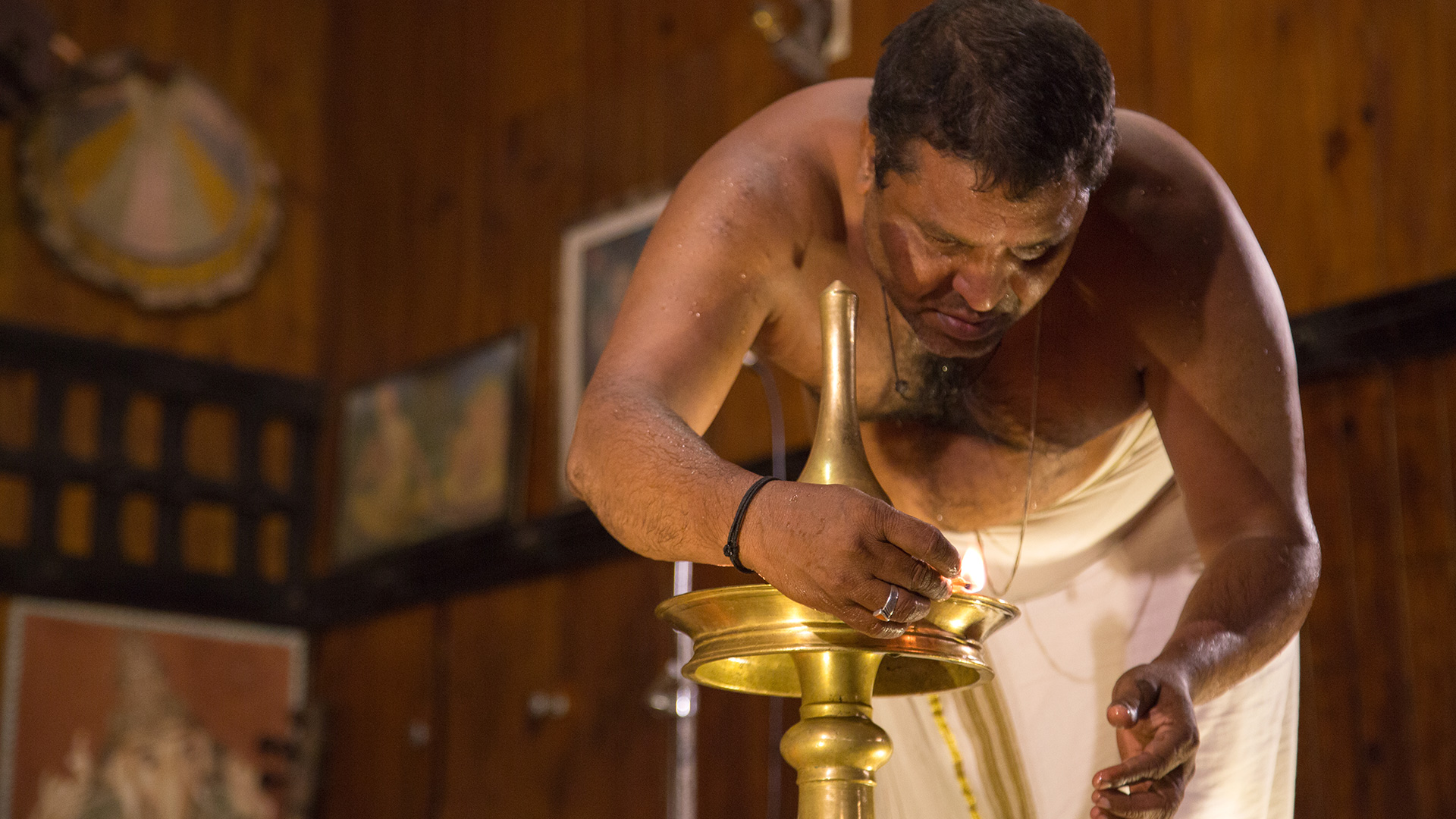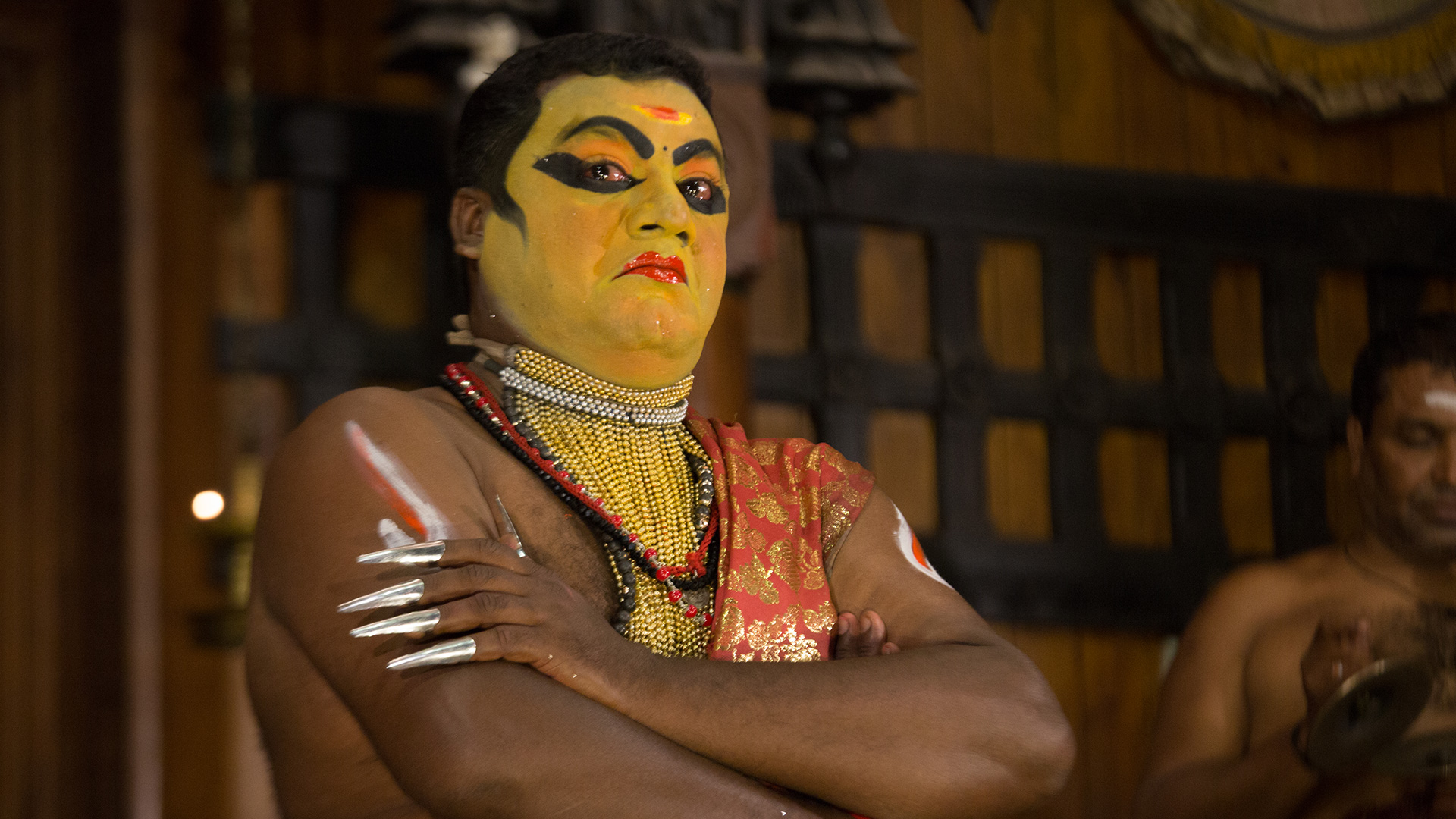
The demon turned his face and looked straight at me, like Shere Khan setting his sights on Mowgli. His garish orange and black makeup succeeded in making him look evil and ready to pounce. I froze, my finger poised and ready on the shutter button on my camera, my breath catching in my throat. There was no Baloo or Bagheera to back me up.
I knew this was a stage performance and that I was being confronted by an actor, not a demon. But he was supposed to be a demon who eats people, and it doesn’t get much creepier than that.
I’ve lived in Asia since I was a toddler. I’ve experienced and seen spiritual warfare firsthand. I’ve even prayed over a demon-possessed woman. But despite my familiarity with this spiritual dimension of Hindu culture, there still was an unsettling element to the Kathakali performance, a form of classical dance native to the state of Kerala, in South Asia.

Actors take the stage in a performance of “The Killing of Baka,” a dance that depicts a battle with a demon. All photos by Caroline Anderson.
The Classical Art of Kathakali Dance
Though Kerala is known for a large Christian population, Kathakali is a Hindu performance art that dates back to the seventeenth century. It depicts portions of Hindu sagas and epics. In the local language, Malayalam, katha means story or play, and kali means art or performance.
Kathakali developed in Kerala out of an ancient classical dance form known as “Ramanattam,” which was once only performed in palaces. The performers must train for six years in a special Kathakali dance school before beginning their career.

A Kathakali actor begins applying make-up on stage as part of his transformation into character.

Watching the application of the actor’s makeup is a part of the Kathakali performance. It can take up to an hour to prepare the actors for the drama.
The Kathakali dance performance I watched is known as “The Killing of Baka,” a story taken from the Mahabharta, an epic originally written in Sanskrit. Just as in the biblical story of David and Goliath, the protagonist in the Kathakali dance topples a giant-like character. But the men on stage play characters in a story that’s much darker than the one related in the Bible.
“The hope that good will triumph over evil encapsulated in these stories can be a bridge to conversation about the greatest victory ever—Christ’s triumph over sin and death on the cross.”

Lamps are lit onstage before the drama begins. Originally, Kathakali plays would unfold from evening to morning, but in modern times, many are shortened to evening performances.
Confrontation between Good and Evil
“The Killing of Baka” is a tale of the confrontation between good and evil. Baka, a demon who lives cloistered in the forest, terrorizes a village by attacking and eating people. A Brahmin, a high-caste member of the community who has been forced to provide food for the demon, approaches Bhima, a powerful prince, seeking deliverance from this plight.
Bhima promises the Brahmin he’ll deal with the threat of the demon. As part of the plan to lure the demon out, the Brahmin gives Bhima a cart of food.

There is no speaking in the play—facial and body movements tell the story. Prior to the play, the actors explain how certain movements have different meanings and demonstrate the movements for love, sarcasm, sadness, anger, bravery, fear, repulsion, wonder, and peace.
Just as David went before the giant Goliath, seemingly underprepared and undersized, so Bhima courageously approaches Baka. Bhima starts snacking on the food in front of Baka, taunting and challenging him.
Goliath scoffed at David when challenged, saying, “Am I a dog, that you come at me with sticks?” (1 Sam. 17:43 ESV). Similarly, Baka does the same to Bhima: “What’s this? What arrogant fool comes here to challenge me? Who dares threaten me and increase my wrath?”

A prince faces off against a demon in the Hindu dance “The Killing of Baka.”
With confidence similar to David’s in the biblical tale, Bhima tells Baka he’ll kill him with one blow. And he does.
I was tempted to think this tale was a tad gory, but then I remembered that David told Goliath he would behead him and feed the carcasses of the Philistine army to the birds and wild animals (1 Sam. 17:46).

When Bhima (left) defeats a demon, good triumphs over evil.
Longing for Good to Triumph
In both the biblical story and the Hindu epic, good triumphs over evil. But unlike David, Bhima doesn’t give the glory to God for his victory. Instead, his responses to Baka are arrogant.
Stories like David and Goliath and Bhima and Baka have the power to resonate across various cultures because they hinge on the truths of the human experience. In the case of these two stories, they tap into mankind’s longing for good to win in a contest against evil.
As believers, familiarizing ourselves with traditional stories like “The Killing of Baka” gives us an excellent segue for sharing a Bible story. Connecting Bible stories with well-known local stories opens up opportunities to communicate the meaning of gospel truth.

A Kathakali actor demonstrates some of the meanings of the face, neck, and eye movements. The actor darts his eyeballs around at a frenetic speed. By the end of the demonstration, the actor’s eyes are as bloodshot as if he’d pulled two all-nighters fueled by Red Bull.
Does Good Always Win over Evil?
Americans usually like a happy ending. Our narratives tend to climax in victory over evil. I’d wager that’s because our hearts were programmed by our Creator to long for good to triumph. We long for a return to paradise that never ends—a Garden of Eden story that doesn’t end in exile.
But real life doesn’t always supply a happy ending. We aren’t guaranteed we’ll be healed of cancer, find Cinderella’s glass slipper, or see our Shere Khan-like nemesis brought low.
The absence of a short-term happy ending may cause a crisis of faith. Struggle, illness, or opposition can make us feel like God is not always good or that he doesn’t have our best interests at heart. We may wonder why God doesn’t always grant us happy endings in the dramas of our lives.

The Ultimate Happy Ending
Our life sagas might be tainted by tragedy and difficulties, but that doesn’t mean God can’t work through tragedy for a future triumph. We’re drawn to stories where protagonists overcome odds to triumph over evil.
David defeats Goliath. Mowgli defeats Shere Khan. And the unlikely hero in the “The Killing of Baka” escapes the clutches of his enemy and defeats the demon. The hope that good will triumph over evil encapsulated in these stories can be a bridge to conversation about the greatest victory ever—Christ’s triumph over sin and death on the cross.
While we recognize that our life stories won’t be resolved in an evening performance, a narrative like “The Killing of Baka” can be seen as a microcosm of the human struggle to be redeemed from evil, to survive and thrive. It makes me long for the curtain call summoning a long-term happy ending that is also a beginning—an eternity with Jesus.
Caroline Anderson is a writer and photographer with the IMB. She currently lives in Southeast Asia. Her childhood in Asia consisted of two important ingredients: braving hot chili peppers and telling people about Jesus.

